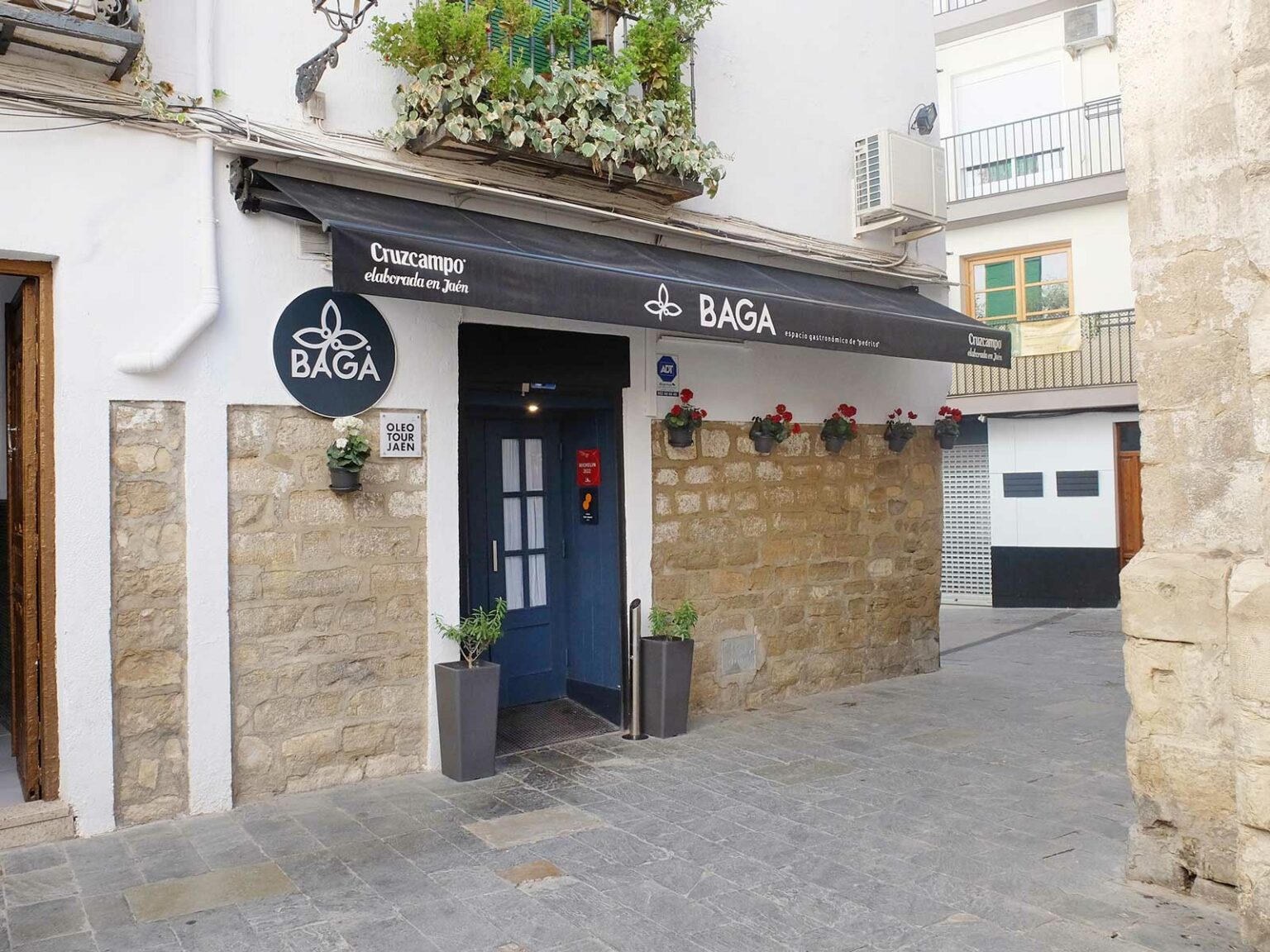I left Bagá unable to express in words all that Pedro Sánchez’s cuisine made me feel. It took me 17 months to feel ready to explain it in writing and to have the calm and time I wanted to dedicate to it. I was very sorry not to be able to do it earlier, but it was the natural time I felt it deserved.
It was not just his welcome, the impact of finding such a small kitchen and venue, his food, his technique, the unusual combination of ingredients, the textures, the flavors, the service… It was the emotions and feelings that it made me feel, I don’t remember having felt them in any other restaurant. A part of tenderness and close feeling, perhaps because I felt as if I was at the kitchen table at home. Not in Ca La Carola’s kitchen, but in my parents’ house when I lived there; not at the dining table, but at the kitchen table, a kind of American bar with high stools. It transported me to the times I spent with my mother talking while she cooked. We would chat about everything and nothing. We talked about food and ate as we talked. She now standing, now sitting, and I more time sitting than her. But always both of us near the kitchen fire, inside the kitchen, in fact.
I don’t remember if I entered Bagá knowing where I was going or what to expect. I do remember that from the first appetizer I felt surprise, disconcert, joy, and pleasure, and I left with a lot of curiosity to know Pedro Sánchez and with admiration towards him, wanting to mentally digest what I had eaten and lived. I was happy, among other things, to see that there are still chefs who think.
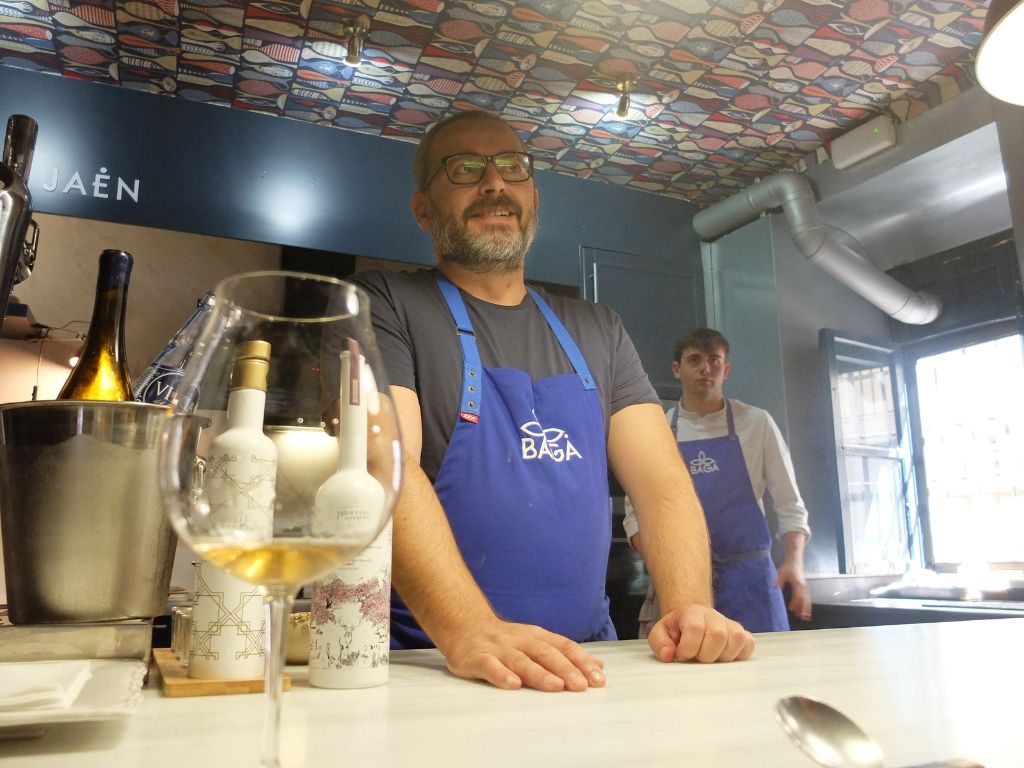
His person and his cuisine made me feel emotions during the meal, everything flowed naturally, and I connected very quickly from the first bite. But he also made me feel feelings that are much more elaborate than emotions that come and go. It was a meal that affected me very positively. Both the book I read afterwards and thinking about his dishes stimulate thought and reasoning and have made me very happy. The book is like talking to him, like having him at home. I have read and reread it, I have it in the dining room, and I often open it and read a couple or three sentences as if it were a proverb or an aphorism, and I ponder what it says. A book that teaches you to think and to look at things from another point of view.
Apart from making a more objective and technical analysis of his cuisine and of the whole meal, I felt the need to express how I felt on a sentimental level, an aspect that I normally overlook in my chronicles and that I don’t often think about: how did X restaurant make me feel?
I’m dying to go back for the food, but especially for him, and also to learn more about the region and its products. All these months I’ve had strong temptations to go back, but first I wanted to prepare myself, I wanted to learn, I wanted to meet a series of chefs who seemed to have points in common with him, like Niko Romito, Alberto Gipponi, Matias Perdomo, Matteo Baronetto, or Dylan Watson-Brawn (with whom he has just done a “four hands”) and I also wanted to improve in some aspects to feel minimally ready to face a second meal in this place that I already love and where I have only eaten once. This is also very much linked to how my habit of consuming restaurants, my interests, and the way I approach meals have changed. In general terms, this new way of consuming restauration could be simplified with an extremely selective use: reducing the restaurants I go to a lot, choosing more based on what interests me and what I want to know in the short and long term, making a minimal annual planning, contextualizing restaurants and chefs both in their environment and in the history of cuisine, and also taking into account what I feel like eating and enjoy eating, among other factors that I also value. In short, knowing in more depth what seems important to me and dispensing with superficial and insubstantial meals that do me more harm than good.
Having gone to about 25 restaurants a month (in addition to cocktail bars, cafés, and patisseries), at this moment I would be very happy doing 6 in a whole year. That’s how I am. I feel comfortable in monastic, orderly, and daytime life and following the rectitude that has always accompanied me. I could say that I am more fulfilled by 6 well-chosen restaurants and knowing them in depth than by 250 meals out with all the consequences that this entails.
I am passionate about cooking more than ever, it has practically absorbed me, I spend all day thinking about cooking, about food, about producers, about techniques, about meals from years ago… I cook, read, and learn, and study, and I am eager to go to a series of restaurants. But one by one, slowly, with knowledge of what I’m doing. Right now, I am very happy this way. With a reduced consumption but much deeper and more cerebral. A more responsible consumption that makes me feel balanced right now. Otherwise, I would collapse. I feel that I want to follow a kind of sustainable consumption of restauration. The same happens to me with the world of fashion, for example, with clothes and my, until recently, beloved dresses. Perhaps it’s a certain disillusionment. Perhaps it’s that I’m tired of not finding what I like. But I have clearer than ever what I am looking for.
When I left Bagá, I didn’t even feel the need to communicate (or display) on social networks that I had been there. I wanted to say many things but didn’t know how. I could have made a post without saying anything more, but to not say anything, I just don’t emit and that’s it. I wanted to wait, there is no rush to publish and publish.
THE LOCATION
Bagá is located in the center of Jaén, on Reja de la Capilla Street No. 3, a narrow street in the San Ildefonso neighborhood, which, as the street name says, is where the Gothic door with the grille and mosaic of the Basilica of San Ildefonso is located. We are in a province of inland Andalusia, about 150 km from the sea, which would be Motril (Granada).
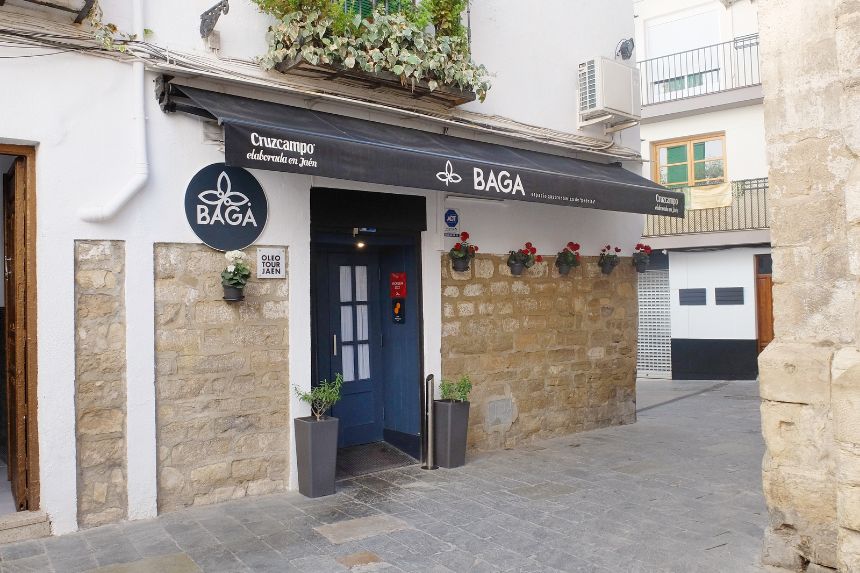
With a discreet facade that goes unnoticed, Bagá is, as they say, a “gastronomic space” of 45 m2 (or 42), of which the open kitchen only takes up about 6 or 10 m2, designed by Raúl Romera Estudio, a kitchen and interior design studio in Jaén.
With a capacity for 8 diners (like Direkte in Barcelona, Kiro Sushi in Logroño, or Ernst in Berlin), it is probably one of the smallest restaurants in Europe. In fact, I would say that there was only one bathroom, indistinct for men and women, and that we had a small team of 4 or 5 people at our service, among whom there were: 2 chefs (Pedro and Miguel Cámara, a 21-year-old young man from Linares); Mari Paz Cano (Mapy), Pedro’s wife and head of the room; and Francisco Javier Fernández (Fran), as a sommelier.
We sat at the bar, a very spacious and beautiful white marble bar, close to Pedro, facing the kitchen, watching him at all times. Behind the motto “Feel Jaén,” very visible above the tiny kitchen, Bagá is the name by which the olive flower is known in Arabic but also a tree from Cuba (Annona glabra). A soundtrack based on a lot of French chanson accompanied us during the meal.
EN PEDRO SÁNCHEZ JAÉN
En Pedro Sánchez Jaén (1977, Jaén) comes from a family that had no contact with the hospitality industry. He explains that his grandmother was a good cook like so many other people, but that there has never been a professional chef in the family. As happens to many teenagers, when he finished high school, he didn’t know what career to study, whether to go towards humanities or sciences, and he decided to enroll in the La Laguna Hospitality School in Baeza (Jaén) to discover what cooking could be, and he left there in 1998 being the first graduating class.
Then, he did an internship at Relais & ChâteauChâteau de Bagnols (Bagnols, near Lyon), where he explains that he learned respect for the chef’s profession, good taste in cooking, and the good taste of the clientele. Next, he spent a year with Martín Berasategui at his restaurant in Lasarte (Gipuzkoa), from whom he learned order, discipline, work, and the search for perfection. Then he worked at Tragabuches (Ronda, Málaga) with Dani García and, finally, spent 16 years at the Casa Antonio restaurant in Jaén.
With all this background, he seems to me a patient chef, with a long learning journey in which he went through different stages such as academic training, internships abroad, or training in the working world both in elite kitchens and more down-to-earth kitchens. A long journey in which he was cooking recipes from other chefs and traditional recipes until he decided, once he reached maturity, to fulfill his dream and open his own restaurant. It was on September 15, 2017, he was 40 years old, and we could say that it was then when his creative freedom began, developing a cuisine that did not involve many expenses, in a small project, without major financing, and without having to look for partners.
Even though I had known Pedro for a few years, I visited Bagá for the first time when it was already 5 years old, with 1 star (2018 for the 2019 guide), 2 Suns (2019 and 2020), and still only occupying the 45th place in the Top 100 Europe classification of the OAD. A chef from whom I don’t know other venues or parallel consultancies or caterings.
THE MEAL
The culinary offer was brief, a single “Feel Jaén” menu of €85 (September 2022) with bread, water, coffee, and other drinks apart. A rather low price among restaurants of its category.
To start, a FIRST SECTION: two APPETIZERS served at the same time.
Orange / Bottarga
On the plate, a slice of dehydrated orange with bottarga powder (mullet roe) that they craft in Murcia. An orange from Jaén and seasonal, thinly sliced and dried directly, without soaking it in syrup. Nor did he add any type of sugar, glucose, or additive. He wanted the result to be as natural, crystalline, and crunchy as possible. I like to see that it is not one of those lyophilized slices that Sosa already sells.
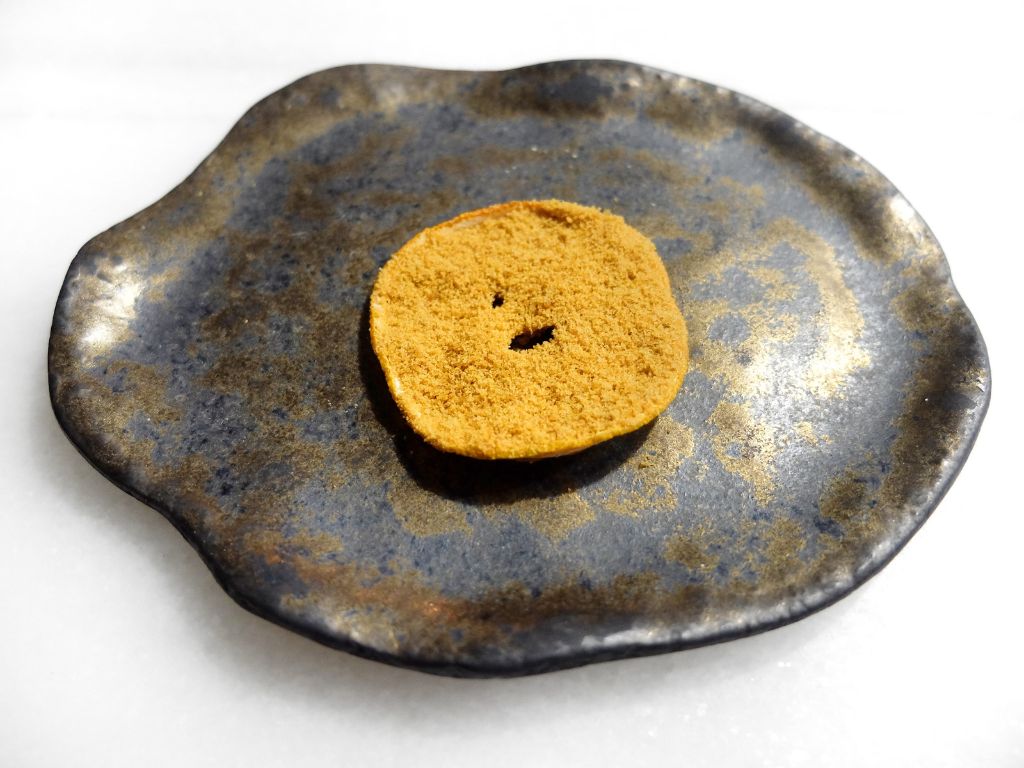
Pedro explains that orange goes very well with olive oil or honey, but those ingredients would have made it an excessively sweet appetizer. Then, he tried to decipher the taste of the orange and realized that what it lacked was salt; that’s why he added the powder of mullet roe, very similar to mojama but with much more depth and umami.
A kind of slightly crunchy wafer with a fantastic contrast of tastes (acidic, sweet, salty, and umami). A salty orange, a marine orange.
Carrueco
In the bowl, a consommé of carrueco, the name for pumpkin in Jaén and with which they make carrueco frito, a traditional stew of the province made with pumpkin (in this case a long pumpkin, must have been a violin/peanut type), garlic, chili (bitxo), and olive oil. In the bowl, they serve the juices that this pumpkin purée releases as it is filtered.
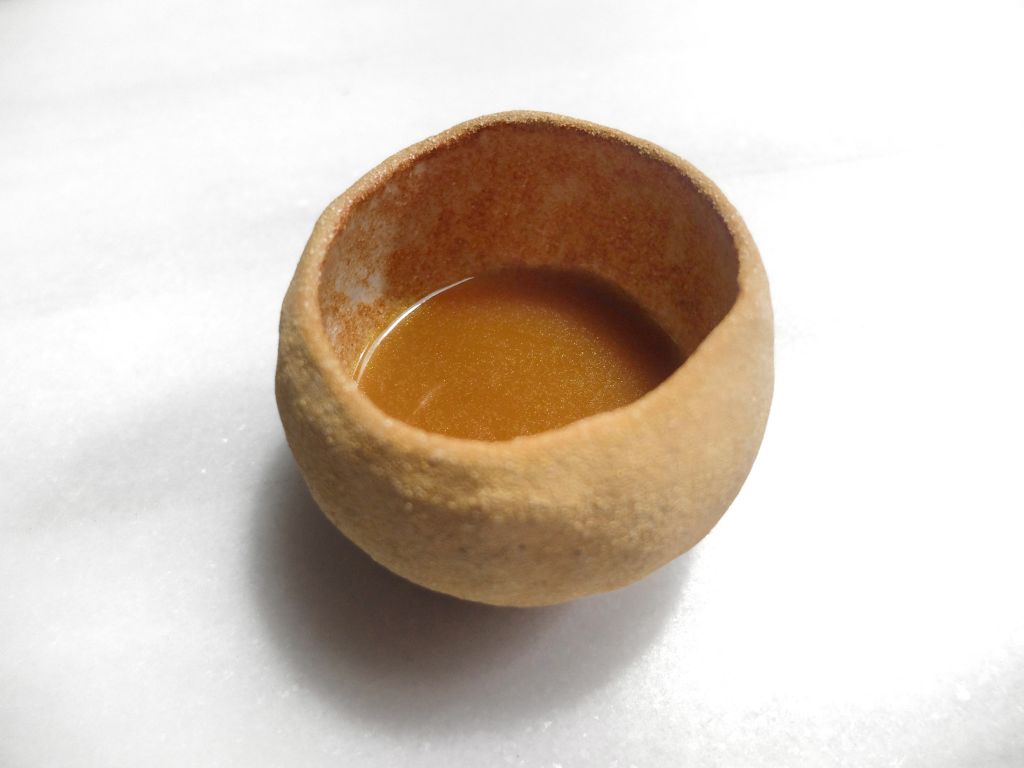
Served hot, as I like to start meals. It had dots of oil on the top layer. A reconstituting and intense gulp. A traditional recipe that I remember he also made into a fritter.
THE BREAD
Torta de aceite
They serve the bread: a piece of a kind of oil cake or focaccia with coarse salt on top. Very oily, it is made by the Viena La Baguette bakery in Madrid and he shapes it by adding more oil. In the oven, they use Almaoliva Bio oil from Almazaras de la Subbética (Córdoba) based on Picudo, Picual, and Hojiblanca; Pedro must add some oil from Jaén based on Royal or Picual.
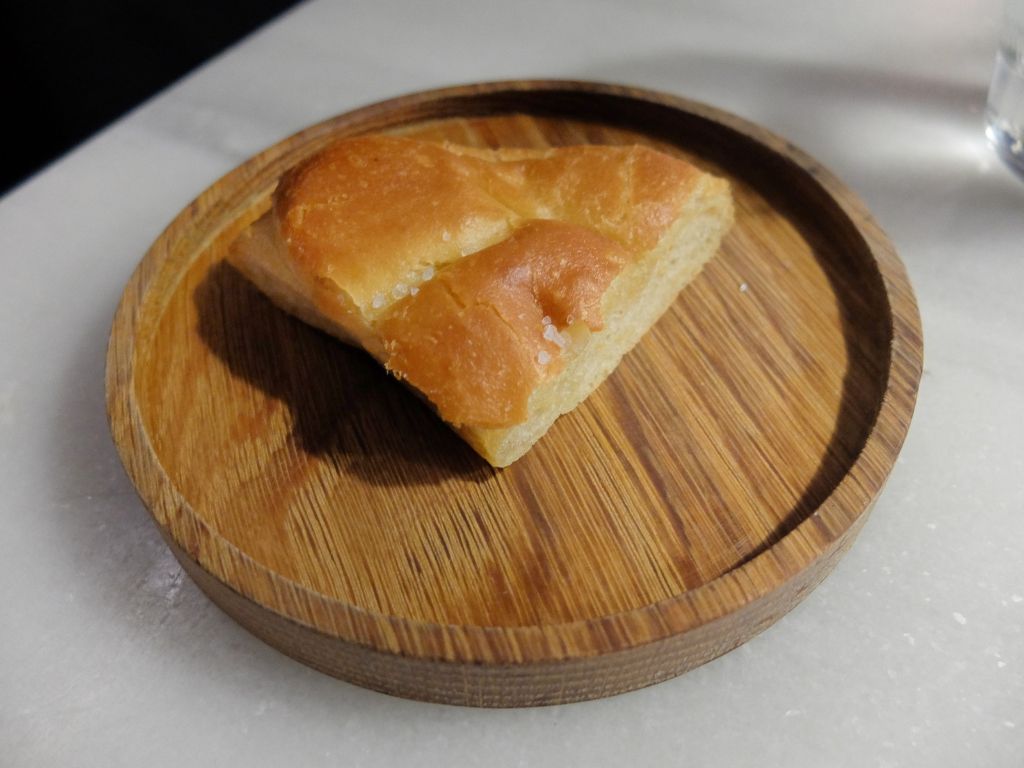
Delicious. A cake only of oil and golden on the outside but soft, nothing to do with Sevillian tortas like the famous ones from Inés Rosales that are thinner (slimmer) and crunchier (the dough is more similar to a puff pastry) and, moreover, contain sugar and anise.
SECOND SECTION OR THE CENTRAL PART
Quisquillas de Motril / Partridge
Three quisquillas (small shrimp) from Motril (150 km from Jaén, in the province of Granada) macerated with oil, shichimi tōgarashi (a Japanese mix also known as the mix of the 7 spices among which there are chili, mandarin peel, nori seaweed, sansho, sesame seeds, currant, and hemp, etc.) and salt for 10 minutes. At the bottom, a sauce based on a pickled partridge, a bird that seems to be also very typical of Jaén and that Pedro loves. I don’t know the origin of the partridges.
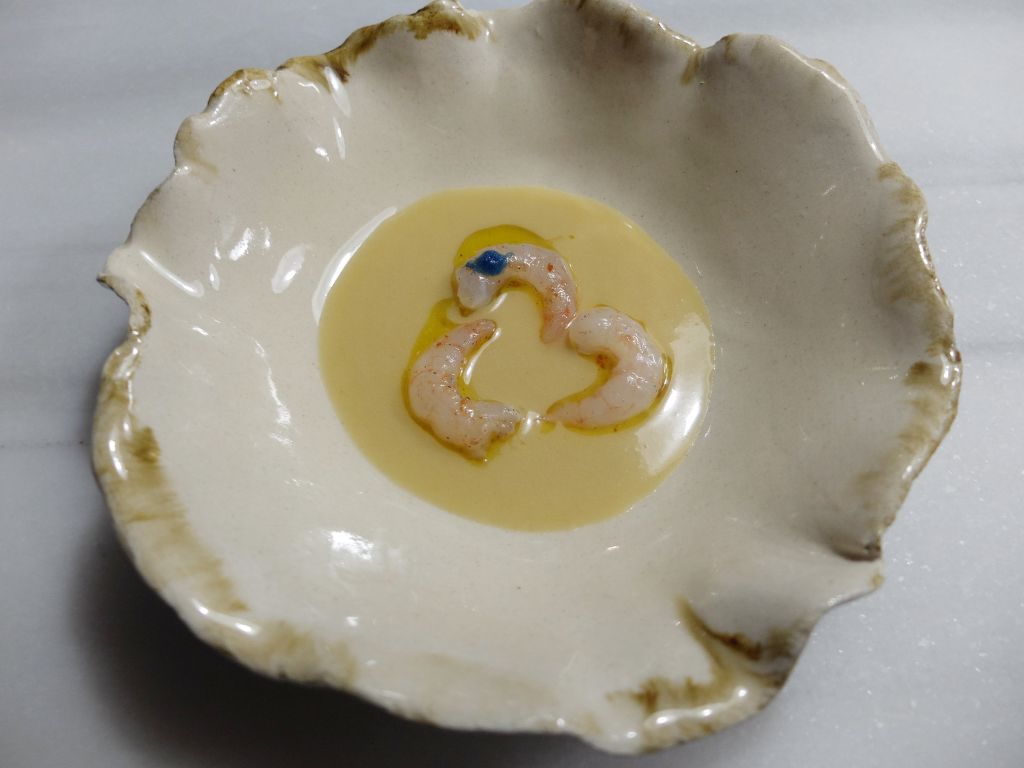
A very personal and representative dish of Bagá that has been on the menu for a long time. A surf and turf where the mountain part is abstractly present in the form of a sauce. A kind of Andalusian ceviche where the acidity does not come from a citrus but from a pickle that was made with rice vinegar, wine (Montilla-Moriles) and apple (each providing a different nuance) and seasoned cold so that the flavors do not volatilize in cooking. A sweet, acidic, and slightly spicy dish. What a joy the blue roe of one of the quisquillas!
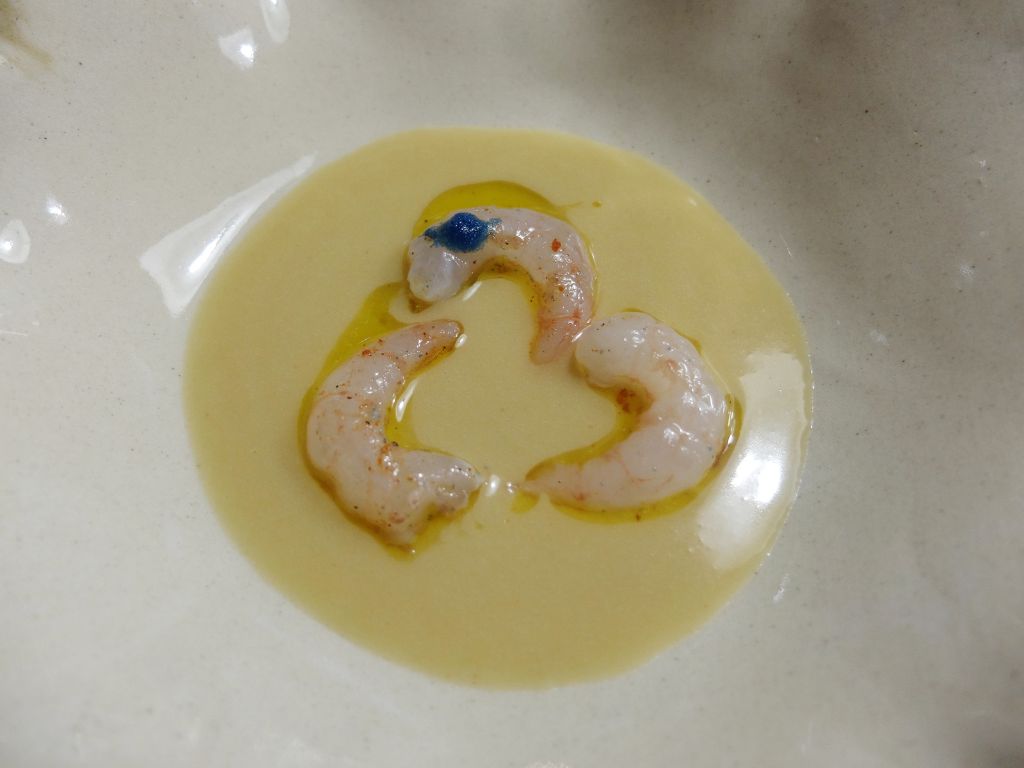
Very good but perhaps the quality of the idea was not as genius as the oxidized pear, with the emulsion of the eel skin stew, for example.
Beetroot / Prune / Rose
A beetroot cooked in a prune juice and dressed with rice vinegar flavored with rose; on top, a rose petal. It was recommended to break and chop the rose petal with your hands and accompany it with the slices of beetroot without trying to chop it, eating it as if it were pasta. A kind of beetroot salad (I would say it was not earthy at all) dressed with rice vinegar.
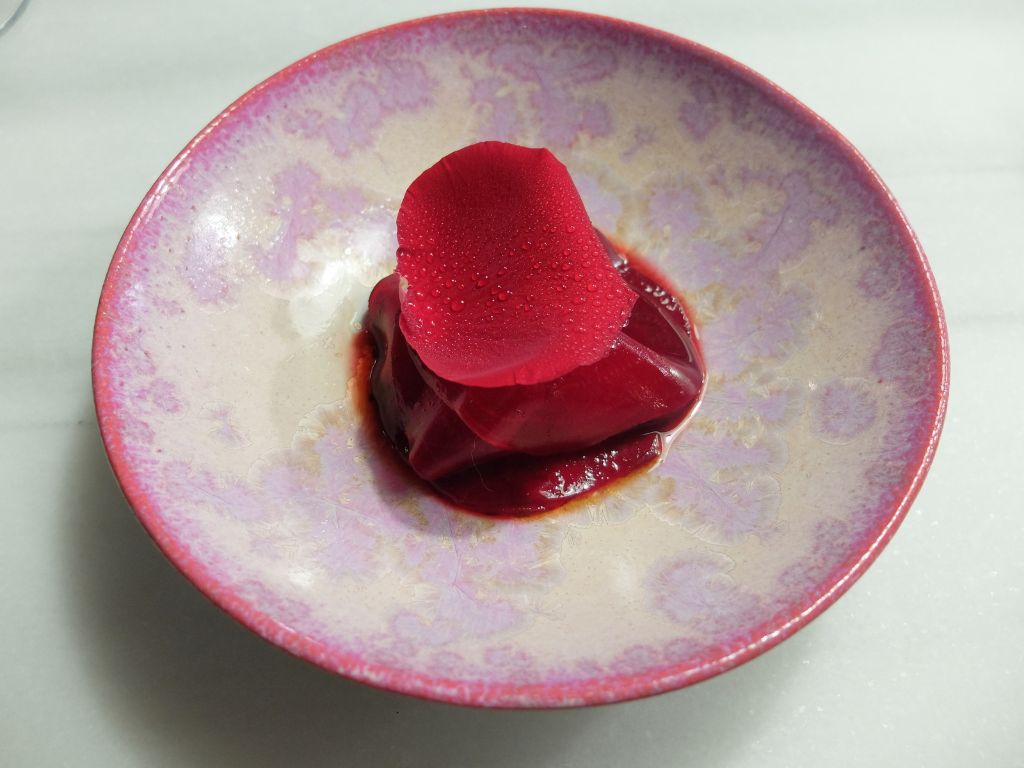
A dish with the sweetness of the beetroot and the sweetness of a dehydrated fruit juice (therefore, even sweeter than a fresh prune) that, although it had no fat, Pedro counteracts and extends with the acetic acidity of the vinegar, yes, a rice vinegar, which is always milder than apple and especially Jerez; and, finally, he returns a touch of sweetness with the rose petal.
Almond / Caviar
On one side, a white sauce, an ajoblanco with brandade of cod and a couple of raw almonds. A very mild garlic ajoblanco that reminded me of Dani García, one of the first Andalusian chefs who dared to change the traditional Andalusian recipe book with his gazpachos and ajoblancos. On the other side, a black sauce based on unpasteurized German Sevruga caviar, cooked sous-vide for 35 minutes at low temperature and passed through a very fine strainer, he explained that in the end only pure water falls. What would seem to me a sacrilege, to grind caviar and break the egg membrane, makes sense at Bagá because Pedro does not look for the texture but the saltiness but a different salt.
He recommended trying both preparations separately and then mixing them. Two sauces of different densities and mellowness. Two marine collagens, the caviar and the cod, both in liquid state.
In the end, there was a taste of lemon. Visually, I also liked it a lot.
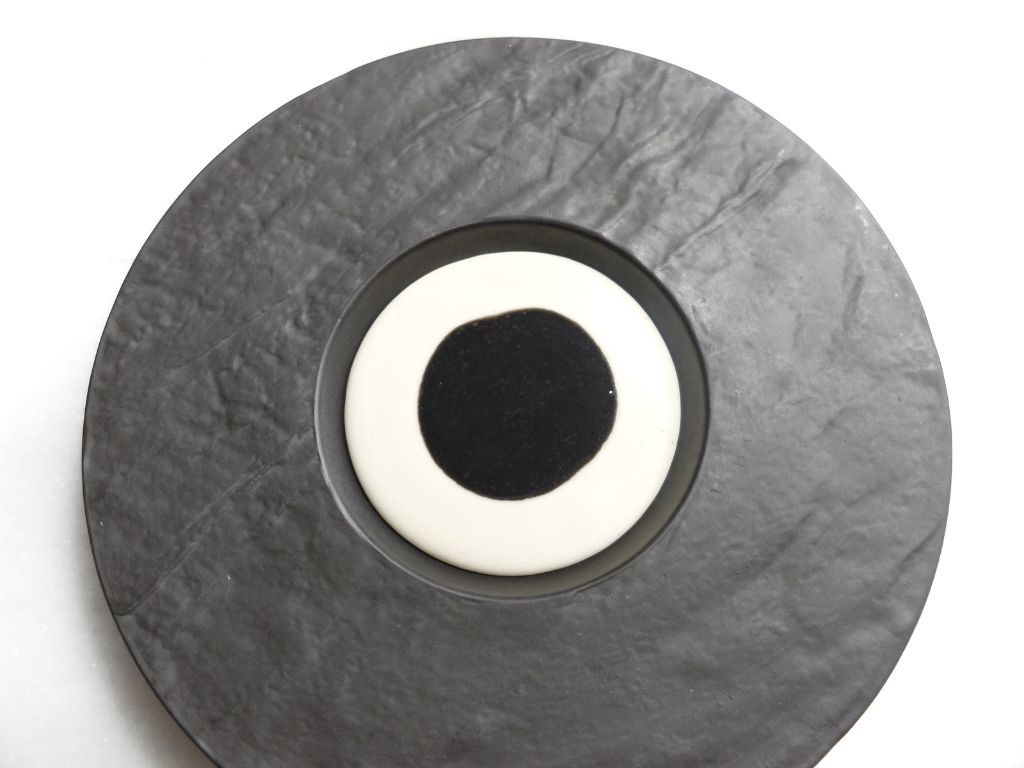
Let’s talk about the Romero Verde oil (Aceitunas Ecorome SL, Úbeda, Jaén) Temprano Premium Quality of Picual that he has on the bar. An oil of an exceptional chlorophyll green color; although the color has nothing to do with the quality of the oil, it was beautiful.
Pear / Smoked Eel Skin
A whole pear, oxidized in an Ocoo (more or less like the cauliflower from Disfrutar or the black garlic), that is, boiled at high pressure for 48 hours.
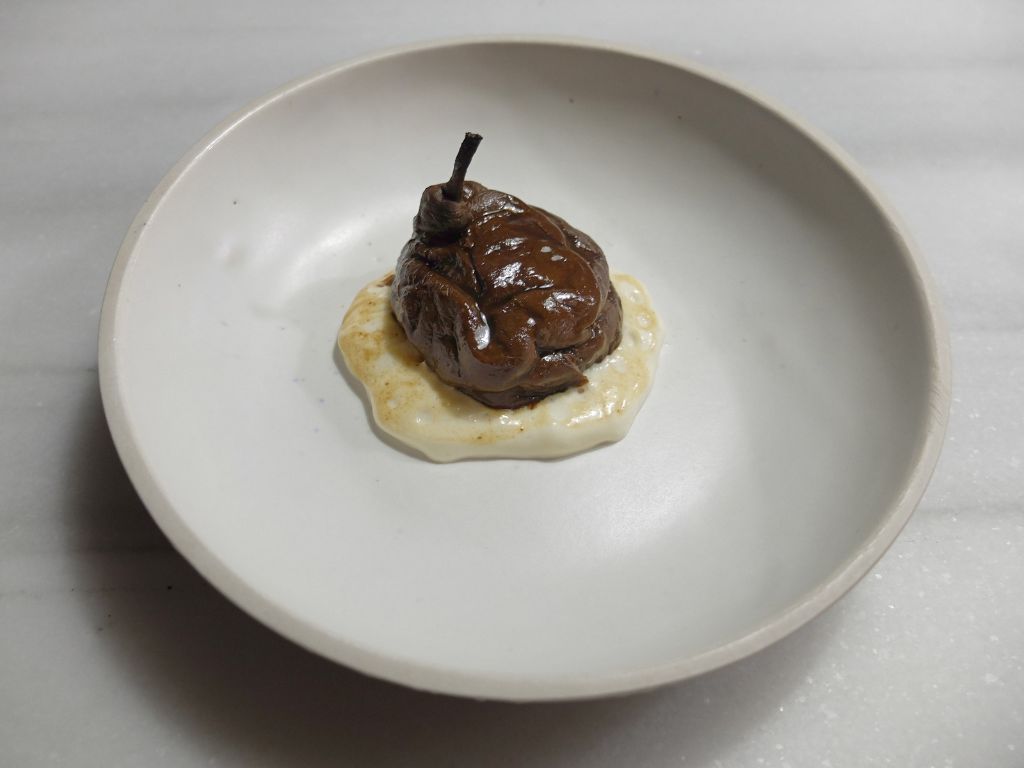
The sweet point of the pear (“caramelized” by the long cooking), without being excessive, and its fineness (smooth and pure) combined perfectly with the unctuousness and fat of the foam that was at the base, made from a stew of smoked eel skins. What a pear, what a texture, it melted! And what flavors! And what a visual effect! Another surf and turf and another dish that endures in memory without the need for photographs or notes.
Coconut / Almond / Pineapple / Basil
Another of his classic dishes that he has been cooking for 15 years. He explains that it is the one that clients like the most, but that he is tired of serving it, that he would remove it from the menu, but that he continues offering it to make the diners happy. It is curious that the most iconic dish of a restaurant can be the one that least represents the chef. In this case, it does not represent him because it is a reinterpretation of a cold soup, because 15 years ago, the association of the flavors of this ajoblanco was peculiar, but now it is not, because his way of understanding the ingredients has changed and now he would approach it very differently. Also, because we have very close taste references; and it is precisely what happened to me in the previous dish “Almond / Caviar,” which made me think of Dani García’s gazpachos and ajoblancos. But, on the other hand, he also keeps it because, after all, the essence of Bagá also goes through everything that Pedro was, because surely, there it already began to originate what it is today.
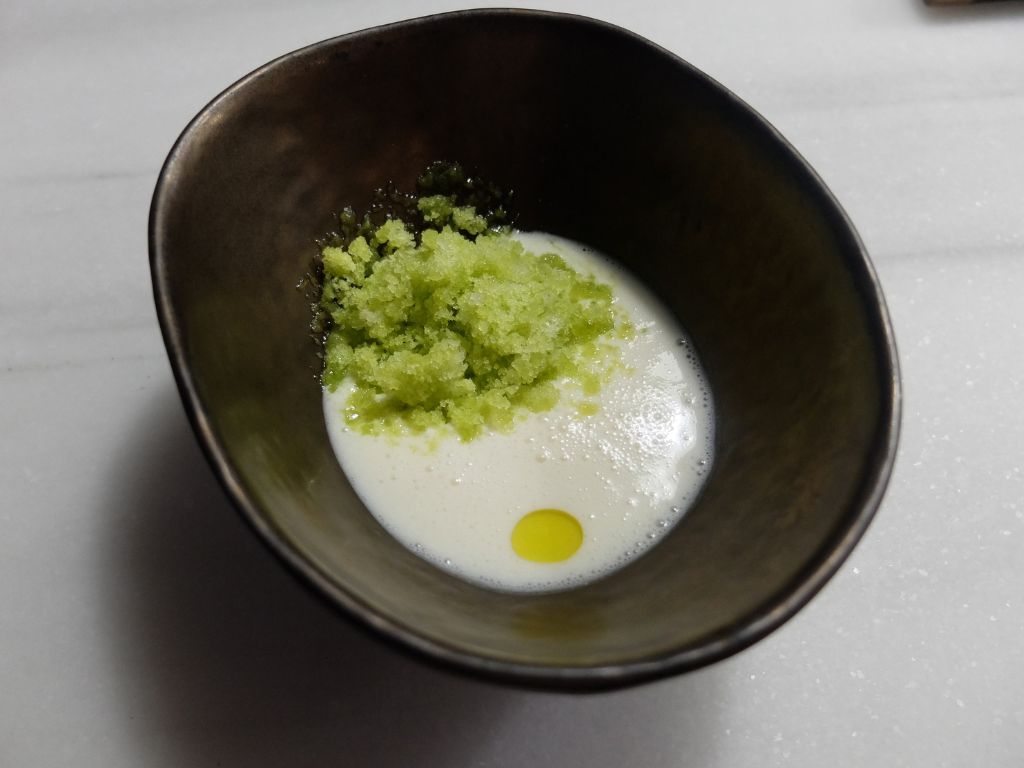
A very refreshing dish. An ajoblanco of coconut and almonds with a pineapple and basil granita that was very mild in garlic. There was also a little oil on top, concentrated on one side and only on top of the ajoblanco.
Once again, an ajoblanco with little taste of garlic and very different. A dish that perhaps could be served for dessert as well.
An important detail, it is the only recipe he has written.
Mushroom / Hake
A raw mushroom, sliced and dressed with collagen from hake. At the base, there were shimeji.
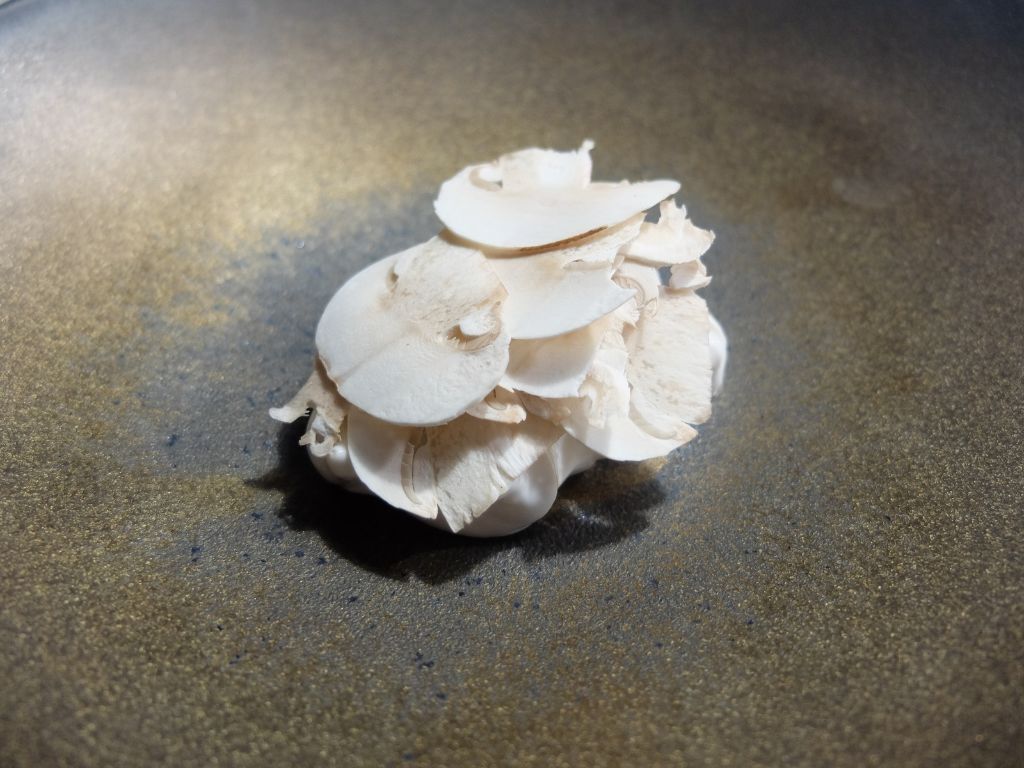
The collagen was more of a mayonnaise and gave it saltiness and texture more than the taste of hake. Another surf and turf. A curious dish because, although they are very typical and recognizable products, Pedro presents them in a different way.
Oyster Île d’Oléron / Green Pepper
Two pieces of fried green Italian pepper from Granada, wrapping two pieces of an oyster cooked for a few minutes in the oven already wrapped with the pepper. At the base, a very light emulsion made with the oyster water and the oil from frying the pepper.
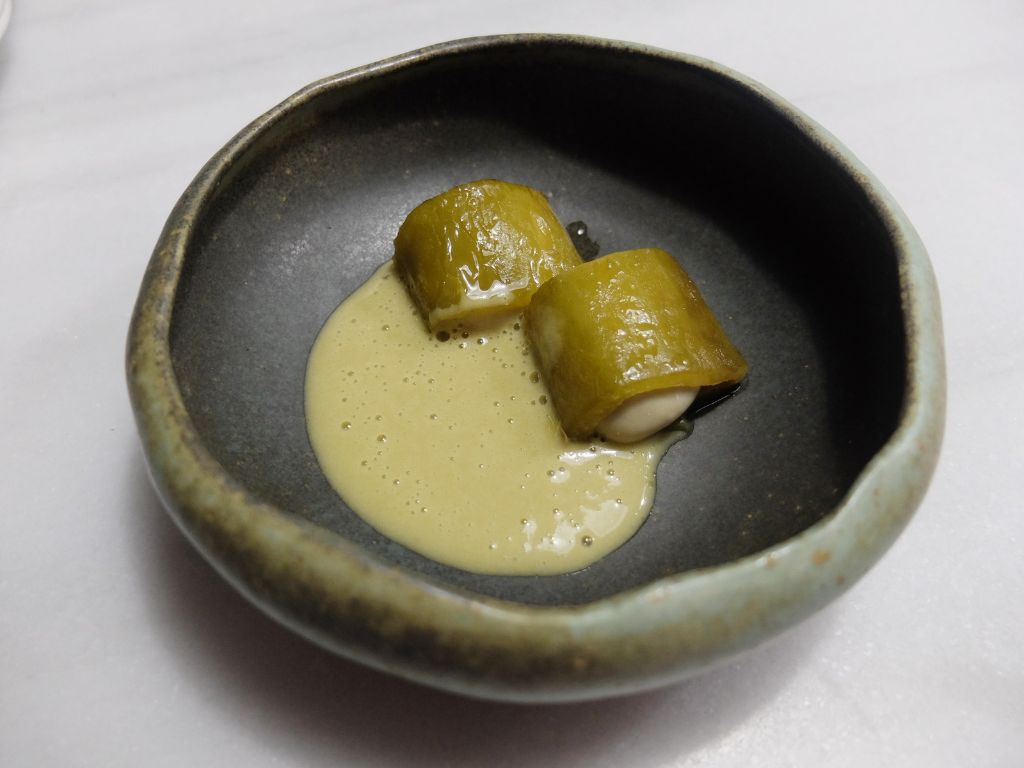
Another curious surf and turf where the oyster is visually hidden because Pedro seeks the real protagonist to be the pepper. Excellent raw material. Finally, a good green Italian pepper! An excellent harmony between pepper and oyster.
A pepper that I will remember like the green pepper (also called “caviar”) roasted and caramelized from Solana de Ampuero (Cantabria).
Nori Seaweed / Meunière
A piece of nori seaweed made à la meunière, with butter and lemon, and with some fried capers.
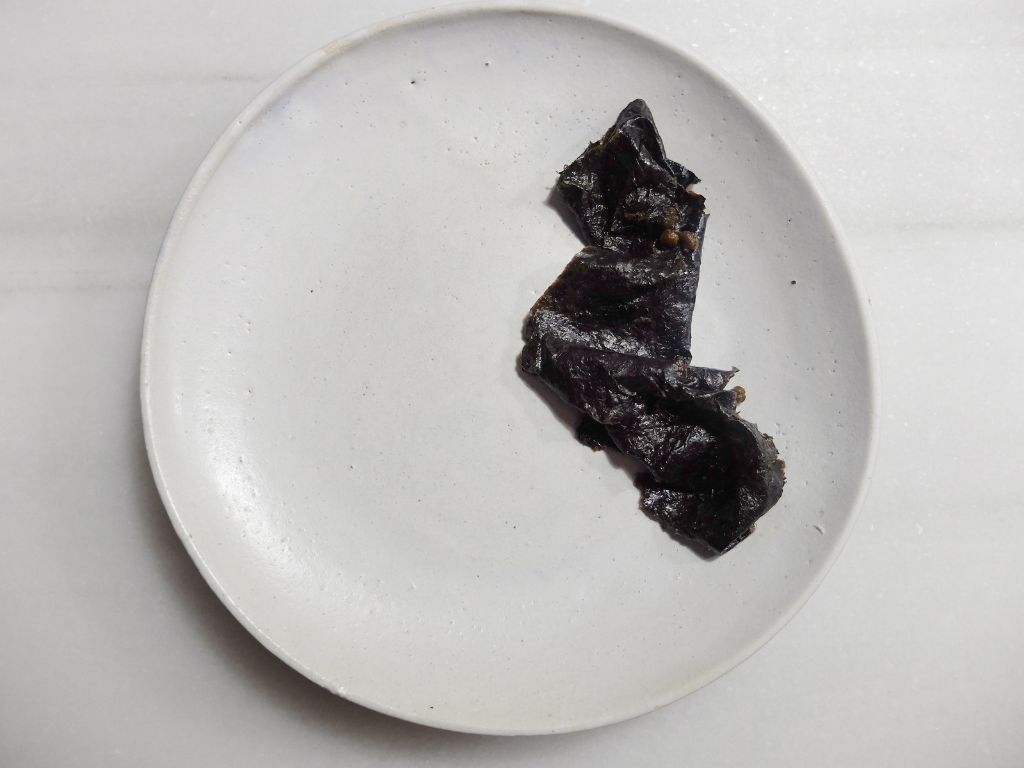
A product that we always eat dry, in sushi, Pedro presents it well moist and hydrated, as if it were the skin of a fish made à la meunière. In fact, it doesn’t seem so far-fetched to me; how many fish tails and fin spines, when they are very crispy, cooking the whole fish in the oven, have the umami taste of nori seaweed! A soft, moist, and greasy nori, with the acidity of the lemon as if it were a turbot with secret waters and with the crunch of the fried capers. Another surf and turf and another dish that endures in memory without the need for photographs or notes.
The texture of the nori seemed like the milk skin of the sole à la meunière from El Celler de Can Roca or the milk skin with cultivated mushrooms from 2012 or the “bitter velvet ideas” from Mugaritz or the yuba from Dos Palillos.
Sea Nettle / Pork Lard / Amontillado
THE PRODUCT AND THE PREPARATION OF THE DISH:
A magnificent sea anemone (ortiguilla, Anemonia sulcata) from José (Pepe) Pérez (better known by the nickname Sea Nettle), one of the 4 licensed divers in all of Andalusia and one of the two who still continue selling them fresh. This one was from the area of Motril (Granada), where the Asian seaweed (an invasive seaweed called roña, Rugulopterix okamurae) has not yet completely extinguished the species. A product that, if the Administration continues to do nothing, will become extinct and we will not be able to continue enjoying it. In fact, in Cádiz and Málaga there are no longer any sea nettles, nor sea urchins, nor caracolas (Charonia lampas).
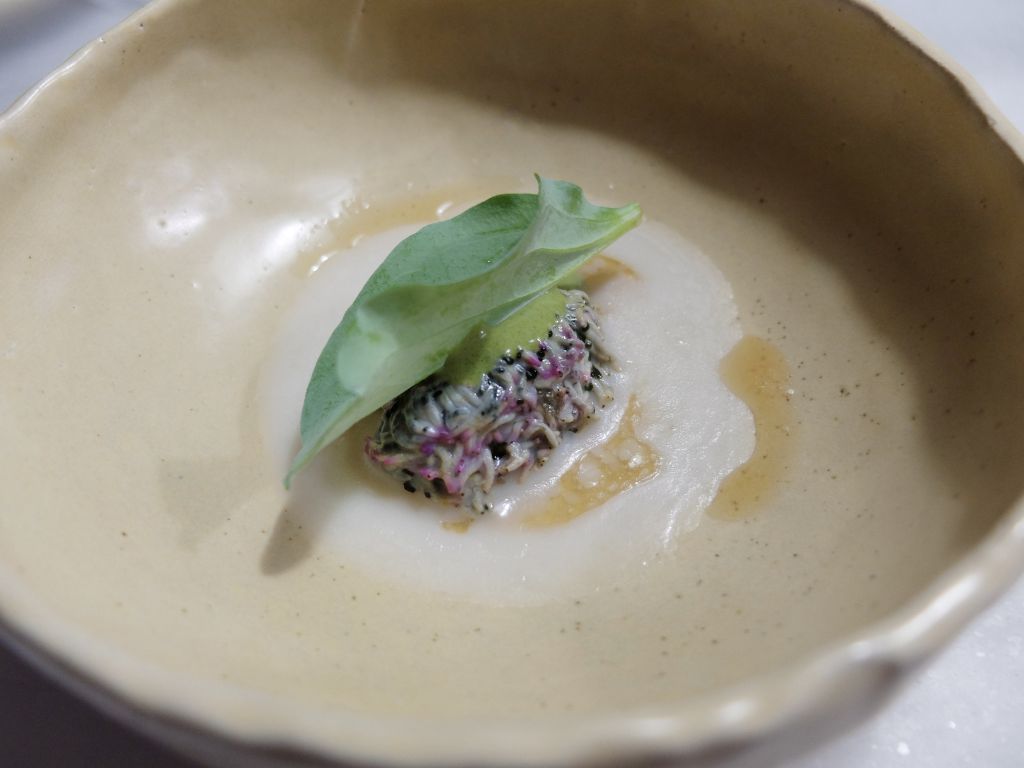
A nettle confited with pork lard (the fat of the pig, the leaf lard) and flavored with Amontillado, that is, cooked in a pot for about 5 minutes at 85ºC.
At the base, the white sauce was this pork lard in liquid state. On top, a green sauce made of lard, Amontillado, and nettle ground to enhance the taste.
On top of everything, a raw oyster leaf (Mertensia maritima), I don’t know if it came from Normandy (France) or from where specifically.
ORGANOLEPTIC DESCRIPTION OF THE DISH:
A delicious sea nettle, very intense, meaty, with a soft touch and very unctuous. An exceptional product, a gastronomic delicacy that we can rarely taste, and much less so well cooked and respected. For me, much better than breaded and fried.
The taste of Amontillado was noticeable, it was mild, it seemed very young.
The oyster leaf had its characteristic taste of oyster, sea, and iodine but also with an aromatic touch of cucumber. With a very crunchy texture, it is a very tasty herb that I usually eat accompanied by fish or shellfish. For this reason, in this sense, I find the combination with pork lard more daring than with the oyster leaf.
Another delicious surf and turf.
In terms of taste and texture, on one hand, we had the saltiness, iodine, sea taste of the anemone (marine taste with a soft, mellow and viscous texture, a bit gelatinous too) that was enhanced by the oyster leaf (marine taste with a crunchy texture); and, on the other hand, the taste of the lard sauce, which I would say was mild and not at all rancid.
Seeing the milky white color of the melted lard while eating an anemone made me think of oyster milk.
CONCLUSIONS OF THE DISH:
A different way of cooking the sea nettle (usually, breaded and fried, where its taste is masked). It is also cooked on the grill, as at Bardal, Tohqa, or Cataria. In fact, Pedro explains that his colleagues from Cataria are the ones who have taught him how to handle sea nettles. The case is that this confit nettle maintained its pure taste and its extraordinary texture.
Pedro had also combined the anemone with a gazpachuelo (which also contained anemone and was also very unctuous) but I find that this combination is more extreme and I like it even more.
However, I found it difficult to eat with that spoon that looked like a small tasting cup with a very short handle. I ate it in one bite (a marine bomb), but some people cut it in half, even though I’m not one to take excessively large bites that prevent you from tasting the food properly.
Trout Roe / Sweet Potato / Tomato Dashi.
In a small bowl, a crumbled ball or a spoonful of very roasted sweet potato (I understand it was roasted in the oven) with a consistency as if they were “fork potatoes.” In the middle of this spoonful of sweet potato “with a fork,” some fresh trout roe or rainbow trout (Oncorhynchus mykiss) from aquaculture in the Segura River (which is born in the province of Jaén, in the Sierra de Cazorla). At the bottom of the bowl, a dashi of tomato.
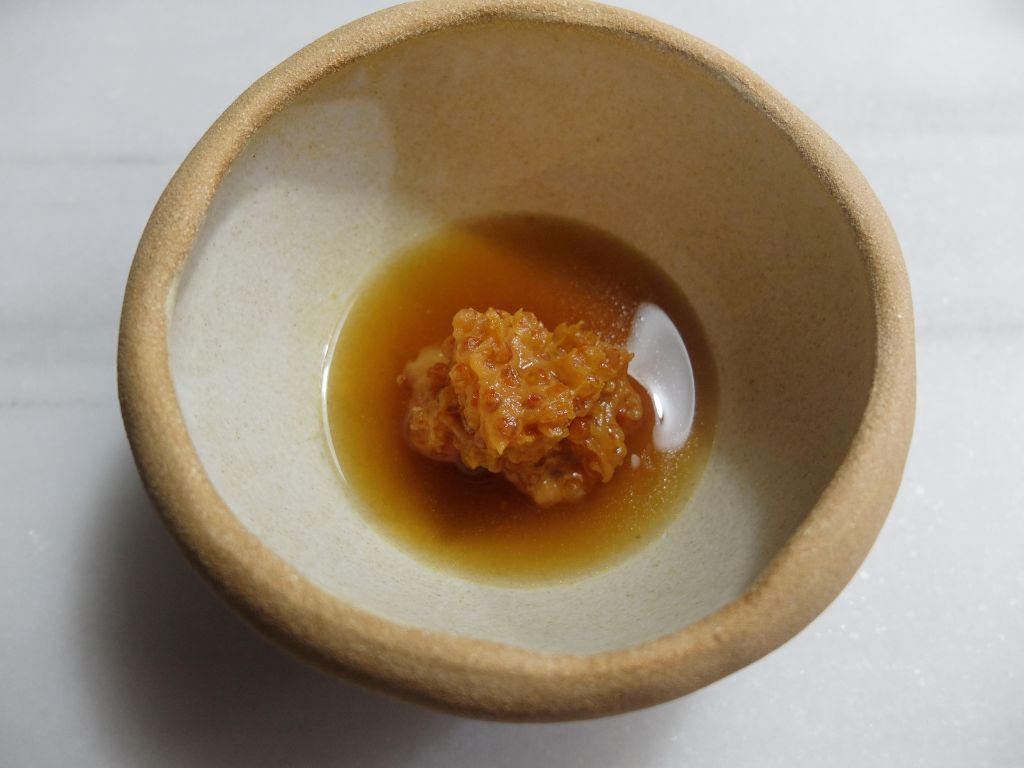
I was not aware that it was really an area of river trout (as long as it rains, because the drought is also affecting them). In fact, a few hours before lunch, we went to the Central Market of Abastos (the San Francisco Market) in Jaén and I was surprised to see so many and, moreover, fresh. They were going for about 7.50-8€/kg. The roe from Bagá were fresh, they were not smoked, the umami taste of the dish was provided by the burnt skin of the well-cooked sweet potato in the oven. It seems that Pedro, since he was little, likes to scrape the tray where they make the sweet potatoes. I understand him perfectly. It also seemed that the dish had a touch of pepper, Sichuan or some type like that.
I really liked the tasty (salty), light, refreshing, and crunchy-explosive effect that the trout roe provided to a food as heavy and less tasty as sweet potato.
Another surf and turf.
THIRD SECTION OR THE FIRST “NON-DESSERTS”
Cod Tripe / Sheep Butter / Flowers
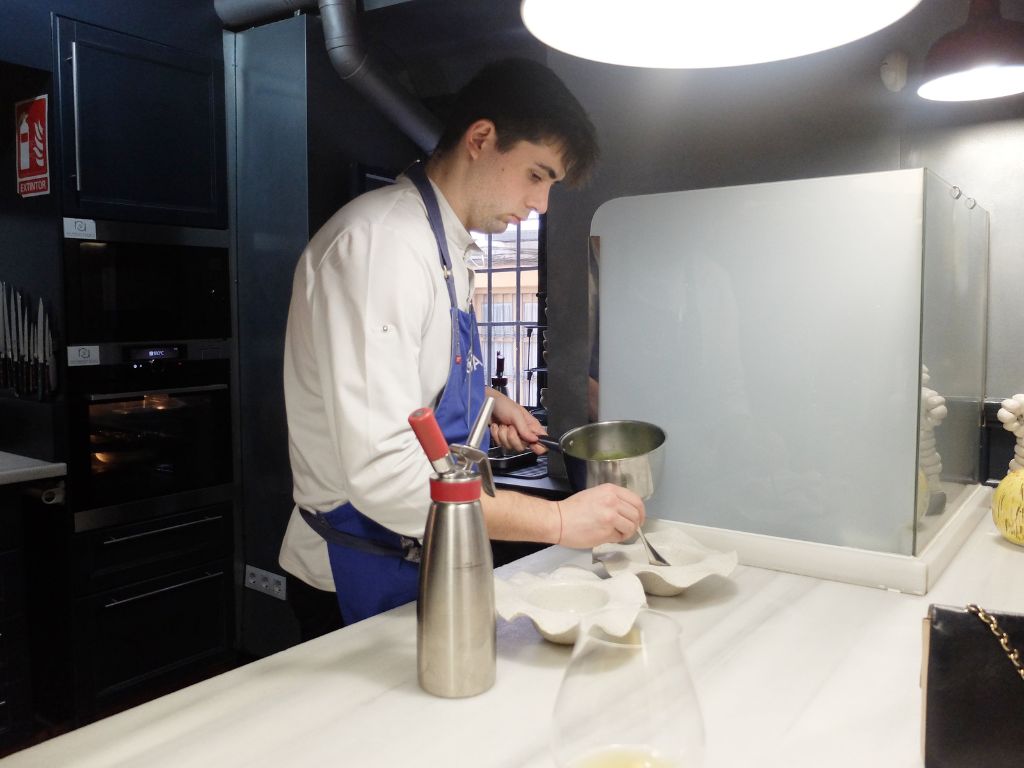
Some pieces of cod tripe that he buys salted from Bacalao Alejandra (Logroño) and, on top, an emulsion from a siphon based on sheep butter from Quesería Calaveruela in Fuente Obejuna (Córdoba). On top of everything, some flowers that, apart from being decorative and adding color and freshness, contributed little taste and aroma; if they were there to counteract the mellowness, I wouldn’t have needed them, I don’t understand this chefs’ mania of canceling the effect of some tastes and some textures through another. At the bottom, a liquid green sauce that was perhaps made of leek.
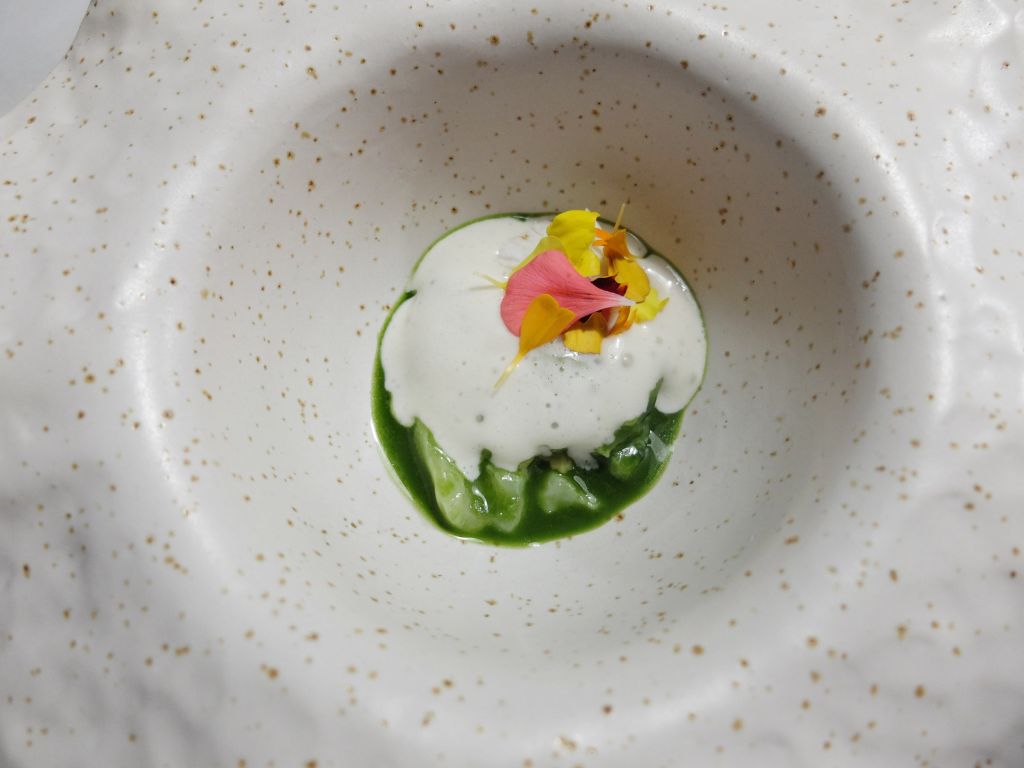
Mellowness of the tripe (denser) with mellowness of sheep butter (more aerated), which was less viscous, less dense, and less heavy due to the aerating effect of the siphon.
Another delicious surf and turf.
Beef / Vanilla
To finish the savory part, a raw and very thin slice of beef loin of Galician blonde with a long maturation of 180 days from Cárnicas LyO that, at the time of service, they temper, cut very thinly, and paint with a vanilla butter in ointment (a soft and creamy butter, perfectly spreadable but not melted) that he prepares with many vanilla beans. On top, it also had some fleur de sel that enhanced the taste of the meat without making it excessively salty, and that’s saying something since I am very sensitive to salty dishes and the maturation process already salts and concentrates the saltiness! A salt placed very intelligently that, in addition, also protected the meat from the sweet nuances of the vanilla.
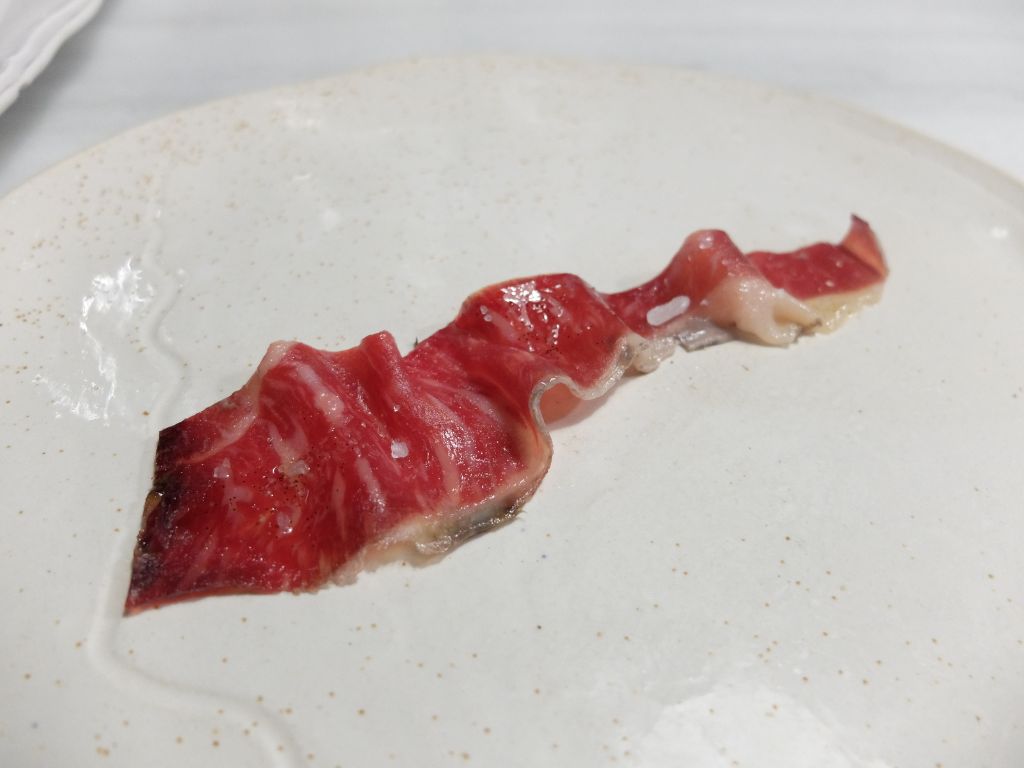
Two apparently opposed products such as beef and vanilla are in harmony by serving the meat tempered and using vanilla as if it were a spice or a condiment, distancing it from its world, the sweet one. On the other hand, Robuchon-style purees that usually accompany meats, carry so much butter that they also end up reminding of vanilla. Seen this way, the combination is not so extravagant.
Pedro says he is not into extreme cures, but if the meat has it, as in this case, he prefers it raw because he understands that the cure is already a “cooking.” I like this vision, I like it because he knows how to set limits, to find the point at which to stop cooking and adding and overloading the dishes. He knows how to put an end and find the moment in which to stop over-manipulating the dishes.
Pedro is very daring, but always with understanding and in a very cerebral way. His extremism is not the result of a crazy person. He grinds the caviar but does not touch meat that already has 180 days of maturation. Bravo!
This slice of beef reminded me of the sublime “Asturian mountain cow with milk and herbs” from Casa Marcial, an extraordinary carpaccio of delicious Casina cow. And, also, with the beef with red pepper from Mugaritz.
Although finishing the savory part with meat is quite conventional, it is a singular and light meat, without sauce, and in which the vanilla prepares you for what will come next: the desserts.
FOURTH SECTION OR THE “NON-DESSERTS”
Chocolate / Iberian Ham
A sauce made from the fat of the ham and a chocolate truffle.
I don’t know if there were more ingredients. I see a liquid and a solid.
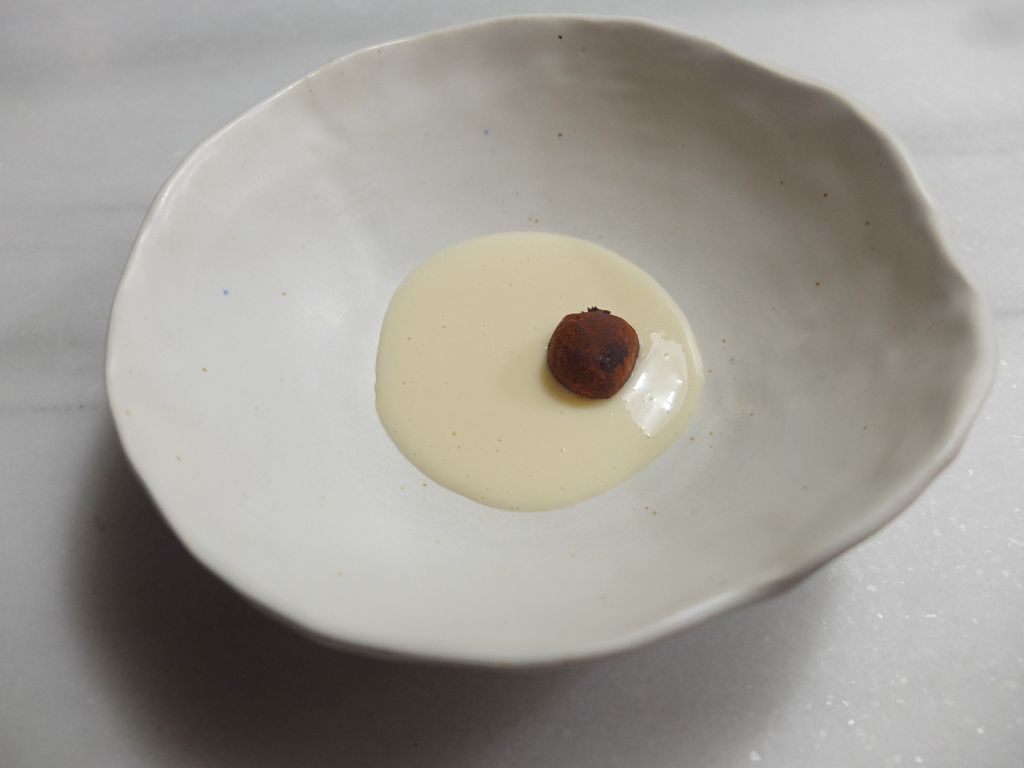
The ham fat sauce was delicious!
Although they are two products that share fruity molecules, I would say that Pedro has not reached this combination based on this knowledge, but from his own reasoning, which makes it a dish fully with his seal.
The union of the bitterness of dark chocolate (I would say it was a chocolate with a fairly high percentage of cocoa) with the saltiness of the ham fat. Animal fat and vegetable fat.
On one hand, we are used to finding ham immaculate, in its pure state, or accompanied by cheese, bread, wine, and even fruit. Combined with chocolate, I remember Paco Pérez’s Iberian chocolate cream (a kind of Nutella or Nocilla that replaced palm oil with ham fat) or Toño Pérez’s choco-ham from Atrio, for example. It also reminds me of when I was 6 years old and ate bread with tomato and ham from La Quadra de Calella with a Cacaolat and they looked at me strangely because I liked that combination. In addition, the versatility of ham fat is well known and it is not new to make an emulsion with it or use it for broths or as a substitute for olive oil.
But, on the other hand, it still seems to me a disruptive dish that breaks with everything that has been done before and in which he demonstrates great mastery of the point of salt and the rancidity of the ham fat but also of the proportions so that such a combination is so and so good.
Pedro makes real “sacrileges” and dares to alter the “natural” untouchable and imperturbable state of products such as caviar or ham, transforming them into liquid preparations in the form of sauce. He is a magician who manages to make a great dish out of an atrocity. He is a virtuoso introducing irregularities in the kitchen, naturally, as if it were nothing.
Lettuce / Double Cream / Rice Vinegar
A lettuce leaf in syrup; I understand that it had spent time in a solution of water with sugar or a liquid solution with sugar and that this syrup was also served as a sauce on top of the lettuce leaf. This lettuce was accompanied, on the side, by an ice cream of double cream (I understand it is a liquid cream or milk cream) and rice vinegar that had a powder at the base. An ice cream made by Fernando Sáenz at his Grate workshop (Viana). It was recommended to eat it by mixing the two elements.
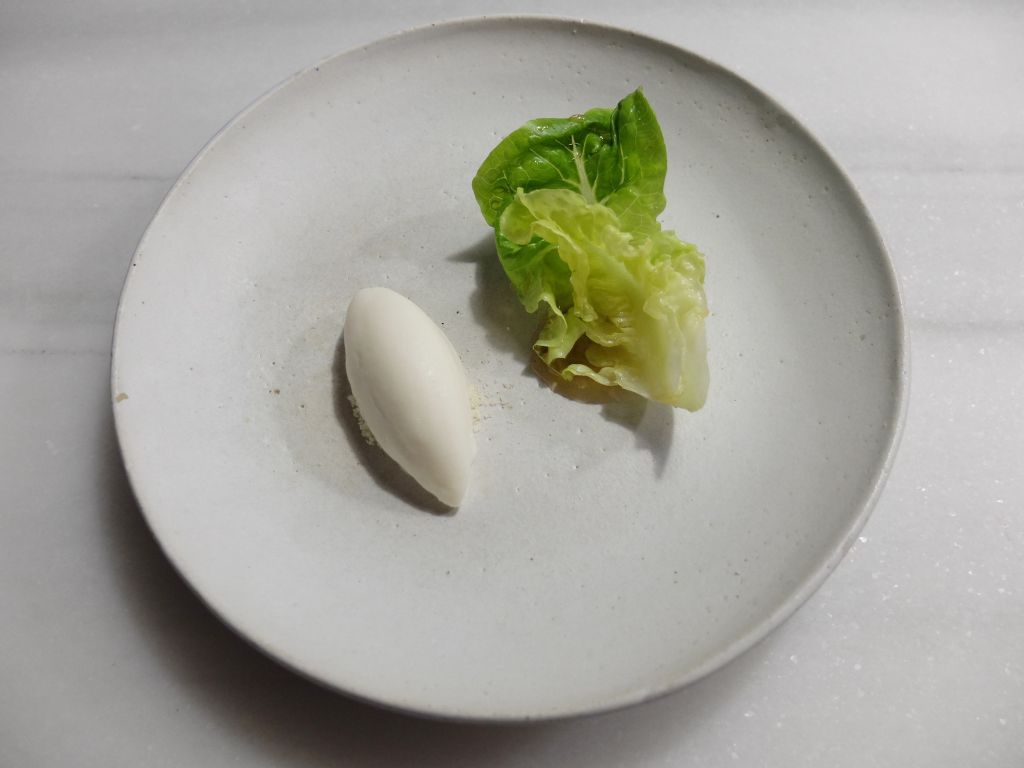
At first, it seemed like a risky combination but gustatorily it was very gentle. In the end, it is still a lettuce with vinegar, although altering the order of the products. The possible bitter point of the lettuce was not noticeable at all, counteracted by the syrup; and, all the fat and creaminess that lettuce lacks was provided by the creamy ice cream. A very fresh and hydrated lettuce leaf. Delicious chlorophyll cream desserts. Another dish that endures in memory without the need for photographs or notes.
Egg / Coconut
An egg, one of the basic ingredients of pastry that, in this case, is served boiled at low heat for about 6 or 7 minutes and “breaded” with grated coconut. I would say that, in order for the grated coconut to stick to the outside of the egg, he had bathed it in a very mild coconut emulsion.
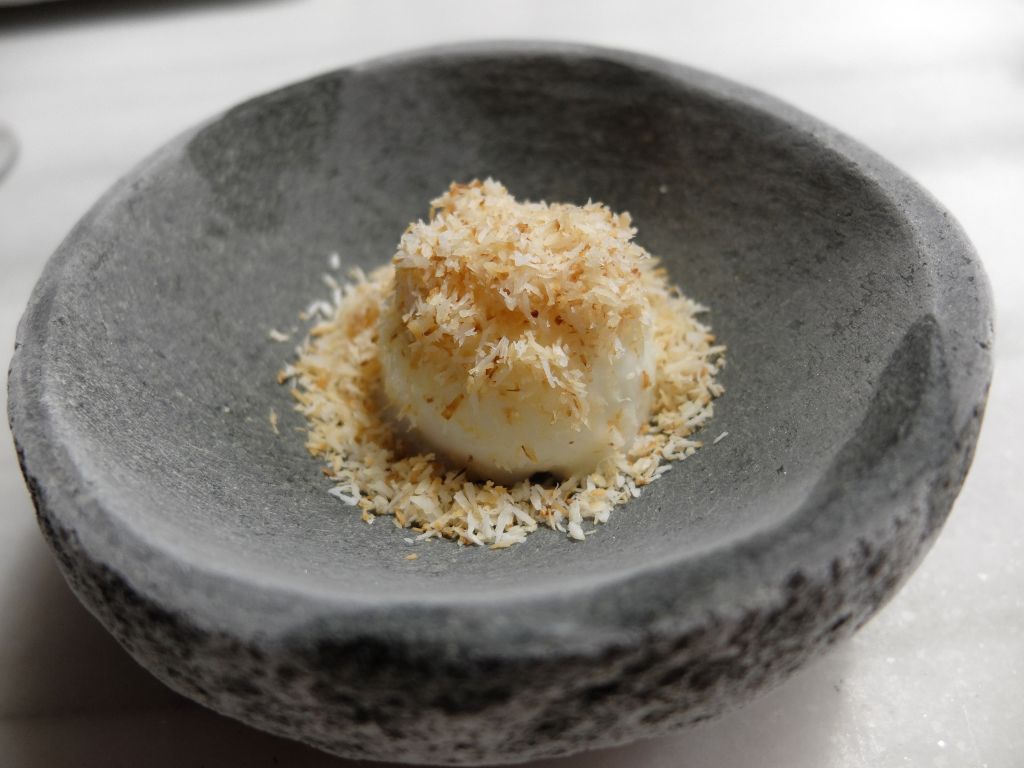
The second dish on the menu that contained coconut, an ingredient little considered and used in haute cuisine. Another dish that endures in memory without the need for photographs or notes.
All three are risky, unlikely, and memorable desserts.
WE DRANK
A bottle of Forlong Amigo Imaginario 2019 from Bodega de Forlong (
El Puerto de Santa María, Cádiz). A Palomino Fino from the Jerez pago of Balbaína Baja (pure albariza) that they elaborate like a red wine, that is, macerating the must with the grape skins and stirring them to oxygenate the liquid during the alcoholic fermentation. Then, it undergoes a 24-month aging in oloroso casks and is bottled without clarifying.
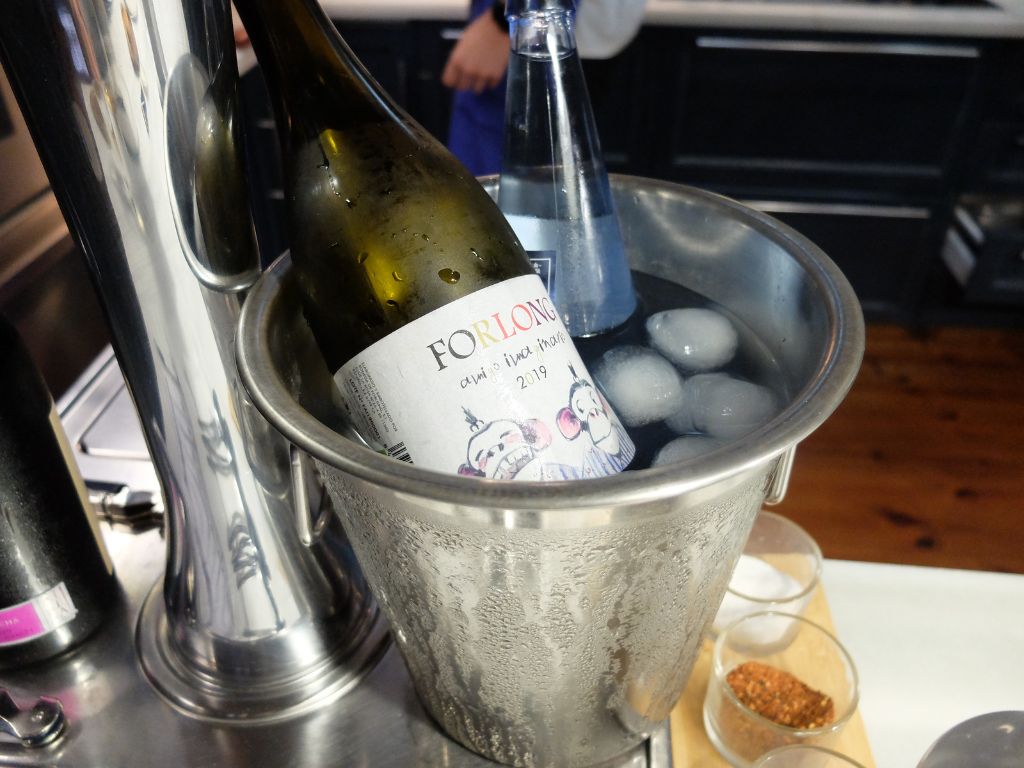
An organic white wine that tried to be a skin-contact maceration, correct but without much aromatic intensity and rather short. It’s hard to believe that it has gone through a 24-month aging in oloroso casks, which are quite oxidative. A perfect accompaniment to be able to focus on the food without the wine having too much prominence.
As for the wine list, it is correct, short, with moderately priced wines, mainly from Andalusia. Both the wine service and the friendly attention of the wine waiter Francisco Javier Fernández (Fran) are adequate for the venue without standing out above the kitchen.
THE STYLE OF CUISINE AND THE CONCLUSIONS
THE CHEF’S PERSONALITY AND THE INTANGIBLES
I would like to highlight Pedro’s soul and sentiment and not just talk about the recipes and his finished dishes. To go further and completely undress him, valuing the intangibles, his personality.
He seemed humble and modest to me, but sure of himself, it shows that he knows what he is good at, what he stands out in, he knows what he does well and he knows what we like about him, his admirers. He seems self-critical, I get the feeling that he knows how to apply the necessary filters when receiving the applause, praise, and good reviews that we give him. He conveys coherence, that he has clear ideas, that he knows what he wants and that he knows himself (his character, his limitations, and his strengths). He seems dedicated, not proud, not vain, pleasant, affable, discreet, and prudent. He conveys kindness in his gaze. He is very respectful with clients; I like his behavior, both in his restaurant and the way he interacts on social networks. He seems sensitive and careful, he takes care of people and products, he has a different look. His treatment is with love and care. He is affectionate and is easy to love.
He writes well, thinks, reasons, justifies why things are the way they are, he asks himself questions, he tastes very well, he has formed his own criteria that has allowed him to obtain a personal culinary thought and develop an enormous creative talent.
We also know that he likes to ride kilometers on his bike and that he likes meteorology and its study.
THE INGREDIENTS
WHAT INGREDIENTS HE USES
Jaén is olives, fried goat, blood sausage, cherries, and almonds.
Without making an apology for ecologism, cuisine of product, of season and quality, or environmental sustainability, he demonstrates having knowledge of the products and the producers, with whom he maintains a dialogue so that they supply him with the products of the caliber, quality, etc. that he needs for each specific preparation.
He works with the horticulturist Juan Carlos Roldán, who cultivates a garden in the municipality of Otiñar, about 10 km from Jaén. He also buys from the Tierras Vivas organic products store in Jaén, the ice creams from Fernando Sáenz from the Grate workshop in Viana (Navarra), or from Cárnicas LyO.
The origin of the ingredients is usually local: from Jaén, like the oranges, the pumpkin, some oils, the trout eggs; from other parts of Andalusia like the quisquillas and the sea nettle from Motril, the green pepper from Granada; or from Córdoba like the sheep butter from Calaveruela. However, he does not close himself to products from outside and resorts to countries like France for the oysters from Île d’Oléron (just north of the Gironde estuary, south of La Rochelle) or Germany for the caviar. He also uses Tahitian vanilla or shichimi tōgarashi.
They are usually ingredients that are not ostentatious and rather cheap.
It should also be said that many ingredients or products that he buys, he manipulates and does not offer them as they are served to him, that is, he tunes them: he grinds the caviar, adds oil to the oil cake, adds vanilla to the vanilla butter from Tahiti that he puts in the beef/vanilla.
In any case, the truth is that when I asked Pedro about the origin of a product, I thought it was like asking Van Gogh what type of canvas or what pigment content the oil paints he used to paint the sunflowers had. That is, with such an important cuisine and that goes beyond in so many aspects, it’s getting lost in absurd, somewhat unnecessary details, which are not the focus of attention or the essence of his cuisine, even though he never neglects them and they are always of good quality.
HOW HE USES THEM
He uses 2 or 3 ingredients in each dish (such as, for example, Bernard Pacaud of L’Ambroisie) but the degree of modification/transformation/manipulation of these is what, in his case, gives complexity.
These 2 or 3 products are the sufficient number to demonstrate that his cuisine is different. A question I find risky because the dish can easily fall if there is no balance between them. It is necessary that the dish has spark and a reason, if it were a combination just because, the result could easily be incomplete.
On one hand, he likes to present dishes with 2 ingredients that we know complement each other (white asparagus and almond) as with 2 ingredients that, a priori, we would say are incompatible. There are also other ingredients that require various accompaniments but it seems that these do not interest him.
Pedro has an extraordinary look, out of the ordinary, on the ordinary and the common such as an orange, a pear, a lettuce, a green pepper, a mushroom, a boiled egg, a beetroot, or a rose petal. He enjoys giving products a treatment and/or a texture that is not usually associated with them.
He seeks the hidden side of products, he does not look at them like a biologist, nor as a nutritionist, nor from a taxonomic point of view, but from the organoleptic contribution, which demonstrates a great palate and knowledge at the tasting level to have a clear description of each ingredient.
For example, he does not like to add salt or sugar, but he likes to provide them with the nuances already inherent in certain products that are naturally like that, such as caviar or trout roe.
THE TECHNIQUES
He says he is technically a bit limited, it would be hard for me to say so, but if it were the case, since he likes to think and thinks a lot about what he does, the result ends up compensating for this possible lack.
He cuts, slices, grinds, filters, clarifies, strains, dehydrates, emulsifies, macerates, pickles, cooks sous-vide and at low temperature, stews, boils, bakes, oxidizes, fries, makes granitas and ice creams…
THE APPLIANCES
Bagá is not a normal restaurant, it plays in the league of the greats with a homey kitchen. Just as a few years ago we wondered if pizza could or could not be haute cuisine, Pedro Sánchez has shown that you do not need to have the facilities of a large restaurant to grow and develop and offer haute cuisine.
He has a Thermomix, an Ocoo, and a siphon, but it is a kitchen of homey dimensions and equipped, also, with appliances and household appliances with homey features such as: an AEG oven, an AEG microwave-grill, a toaster, a Bosch induction hob, a Beko refrigerator, a small wine fridge. Even the dishwasher is home-sized. He has a small warehouse but also has no space for more appliances. He faces the same difficulties we can find ourselves in, that we would buy and buy but always end up saying “and where will we put all this?”
During the service, he uses the Thermomix, he has siphons in a bain-marie on the induction, where he also has some pots and finishes some dishes in the oven or microwave.
I would say that they don’t even organize themselves by sections, the space and the number of cooks make it impossible. Therefore, the two cooks make a much higher percentage of the dish and the menu than in large restaurants with 50 cooks with very specific and specialized tasks.
THE TASTE PROFILE
It is a clean, neat, spotless, and clear cuisine, where the taste of the products stands out and where sweetness does not abound, neither in savory dishes nor much less in desserts. Instead, saltiness, acidity, bitterness, and umami prevail.
I would not say that the dishes have extreme or difficult flavors, and I also do not remember any that were bad or had a bad taste. The combinations of products are extreme and rare, but not the organoleptic combinations, meaning, the result is never unpleasant like some dishes from Mugaritz, Contraste, or elBulli from the 90s and 2000s that I remember could make me shudder, perhaps due to age and an inexperienced palate.
I think these unusual combinations do not become unpleasant to us because we identify previous taste references. For example, the nori seaweed à la meunière is not unlike the taste of nori seaweed that a fish tail has when cooked in the oven, when it becomes well-fried and oily due to the mixture of oil, gelatin, and all the juices that the fish releases.
The dishes had good aromatic and taste intensity, but without reaching the powerful flavors of a cuisine like Diverxo’s, for example. Rather, subtle flavors abound that require training and attention.
I do not remember having eaten any dish that was very hot; all were from tempered to cold.
Nor do excessively cold dishes abound; there was only one pineapple and basil granita with coconut and almond ajoblanco (Coconut / Almond / Pineapple / Basil) and a double cream and rice vinegar ice cream with syruped lettuce (Lettuce / Double Cream / Rice Vinegar). And within the same dish, I remember few temperature plays, perhaps only the lettuce with the ice cream.
With meats, he is not into cures or extreme maturation, but if the meat has it, as in the case of “beef/vanilla,” he prefers it raw. I would say the same for fish and seafood, as they were all fresh.
Finally, it does not seem that he likes caramelizations, reductions, or the Maillard reaction.
As for textures, there was very little presence of crunchiness; I would say we only ate the orange/bottarga. In fact, due to the reduced space, temperature, and humidity of the restaurant, it seems that he struggles to achieve this texture. On the other hand, liquid and creamy textures (sauces, emulsions, foams, ice creams…) and crunchy textures, whether from vegetables or seafood, are much more abundant.
It can be said that he has worked on an aesthetic of taste, a taste profile.
He intersperses comforting dishes with dishes of slightly more intense flavors and more singular textures, a very important point so that the meal is pleasant and does not become boring or saturating, neither mentally nor gustatorily.
THE DISHES
Pedro offers finished dishes, with a closed recipe, he does not improvise at the moment.
But it is a cuisine that I value not only for the final preparations, for the finished dishes as I ate them, but for the whole creation process. I find that the recipe is not the most important part of the dish, but the process and the reasoning of how and why it got there.
Many preparations have to be cooked in advance due to the limitations of the premises, to avoid making smoke that could bother customers and problems of that kind.
There are dishes that are always present permanently and others that vary throughout the year following the seasons, but I would say that he never offers a completely new menu from top to bottom.
QUANTITY AND TYPE OF DISHES EATEN
- A menu divided into 4 sections (as they appear in the reminder) that I wouldn’t know how to define. He says there are no acts, and to me, it seems too conventional to use “appetizers, main course, pre-desserts, and desserts” because, moreover, they are not conventional desserts. However, I don’t know what word or definition he feels comfortable with: sections, parts…?
- 17 Preparations:
- 2 appetizers
- 12 main dishes of which the last two could already be interpreted as a transition towards the desserts because they contain sheep’s butter (in the case of cod tripe) and vanilla (in the case of the beef). I’m not exactly sure why I say this, as if these two ingredients, in traditional cuisine, were not part of savory cooking.
- 3 dishes that could be considered desserts for being served in the last part of the meal, although it could also be said that there are no proper desserts. Seeing what he cooked at Casa Antonio, I am surprised to see the radical change he has made especially in the desserts. Even though he was not completely free there, I find that in the savory part, some hints of what he has become were already glimpsed, but on the other hand, he was limping in the sweet dishes, which were quite strong.
- I like his desserts, which could perfectly be refreshing starters.
- Excluding bread, he did not offer any floury mass or pasta. In fact, I know few dishes with this type of product from him, like the “buñuelo de morcilla en caldera,” the “spicy corn tartlet,” the “oyster with hard wheat pasta cooked in a tuna juice.” In the menu, there was a greater presence of vegetable (even in the desserts) and marine than meat, with only one meat (the beef/vanilla) which, moreover, was unconventional and served raw, so it could be served much earlier as a cold cut or deli meat. He also serves the partridge but in the form of a sauce, you do not see or chew the bird itself. Even though there is a greater marine presence than meat, it cannot be said that he served any fish properly, but rather seafood: we ate three shrimp, an oyster, a sea anemone, trout eggs, cod tripe, and nori seaweed (caviar, hake collagen, and smoked eel skins presented in the form of a sauce). Finally, the abundance of surf and turf must be highlighted.
The portion size seemed appropriate for all the dishes. With hands, only the orange/botarga, which was an appetizer, and the oil cake, the bread, were eaten. There was no dish that was a single bite.
As for the aesthetics of the plating, it has a modern presentation with a simple and straightforward appearance, austere and minimalist, behind a hidden complexity. Clean plating, without ornaments or frills.
THE STYLE (revisiting some of its characteristics but analyzing them from another perspective)
It is not an ostentatious cuisine, with expensive products and a Versailles-style setting, but it is a cuisine of impact.
For years I have heard about disruptive cuisine. Understanding it as a cuisine that produces a sudden break with everything that has been done so far, I could say that Bagá’s is quite so. A cuisine with a lot of conceptual character, the idea is interesting; but Pedro also gives importance to the product, to technical skills, to aesthetic aspects, and to hedonistic pleasure. A cuisine that explores different culinary paths, supported by creativity to play in a personal and different way.
A chef who has increasingly dared to move to the extremes. Even so, although he offers curious and different bites, they are all fully gourmand, pleasurable, and with many nuances; they encourage you to travel and go to Jaén to eat at his home.
But let’s not only focus on the recipes and his finished dishes, let’s also look at the entire creative process.
Initially, he does not categorize or make value judgments. His cuisine has a much lower percentage of prejudices than the vast majority of cuisines and tries to break away from the rules that we have been taught from childhood were correct. He likes to use products that in haute cuisine, whether for their everyday nature or their more affordable price, do not have the category they deserve. In his cuisine, there is no hierarchy of products. When he designs a tasting menu, a beetroot and a lettuce are at the same level as a lobster or a red shrimp. Each element has a soul and unique peculiarities. Therefore, all are susceptible to being the protagonist of a dish or even to create a dish solely with it. The gastronomic experience of Bagá does not focus on the price of the ingredients, you can find both a pear and caviar. What he does try is that if he works with an oyster or a beetroot, they are the best he can get.
Often, he does not use the products for their taste, but for other properties such as texture, density, or saltiness.
His cuisine shows a lot of what he likes.
On one hand, he likes the partridge (a very typical bird of Jaén), scratching the tray of baked sweet potatoes, the bitterness of beer, the lettuce and mayonnaise of sandwiches, the early olive oil, the white asparagus with mayonnaise, the tomato and cucumber salad that is so eaten in summer… He has a good memory of the spun egg (increasingly out of use), it transports him to the Christmas season. It makes him think of his grandmother, who served it for Christmas with a roasted turkey. He likes to eat and enjoys different styles of cuisine, demonstrating an open mind and a transversal passion for his profession. We agree on so many points…
On the other hand, he does not like to interpret the recipes of others or traditional recipe books, of recipes that already exist. He is not interested in mixtures that he already knows are good. He is tired of cooking comfortable dishes. He also does not like that vacuum cooking is only used for meats and fish, forgetting to cook vegetables with it. He does not value meats much and is not into extreme cures, but if the meat has them, as in the case of “beef/vanilla,” he prefers it raw.
Even though his creative style is based on unusual combinations of ingredients, he doesn’t reach it through molecular cuisine or solely through the creative Bullinian process of adapting sweet recipes to savory and vice versa. Instead, he reaches it through:
-Cooking:
- From leftover preparations generated during cooking, he thinks about how they could be utilized in a dish.
- For example, he takes advantage of the juices and waters released by products during cooking, such as the water from vacuum-sealed and low-temperature cooked lettuce or the water from roasted peppers, which he reduces for some dishes like “almond, pepper, caviar.” He also makes a foam from a stew with smoked eel skins.
-Asking questions like how to balance a dessert that contains olive, for example:
- He asks himself:
- How can I reduce the intense flavor of a product?
- Which product can provide me with salt? And sugar? And which one can provide me with both salt and creaminess or salt and crunchiness?
- How can I make a combination not cloying?
- Why should a dish continue to be served?
-Analyzing and taking a detailed look at traditional cuisine (from dishes like afternoon snacks of bread with oil and chocolate with a piece of orange prepared by his grandmother, to sauces like romesco).
-Analyzing the product from a gustatory, sensory, and organoleptic perspective, proving that he is an exceptional taster.
-That is to say, first of all, he cooks, then he asks questions, and finally, using all the knowledge he has as a basis, he thinks for himself about how to find the solution. These are kinds of culinary puzzles that I also increasingly enjoy and am excited about. I really like thinking about what is eaten and what we eat, and I also like to rethink what we have eaten over the years in a specific way.
- It doesn’t seem to me to be a cuisine that is the result of spontaneity, but rather of thinking and many trial-and-error experiments.
- A THINKING CHEF:
- Being guided by the palate to nourish oneself gustatorily or to eat a couple of dishes in a restaurant is not wrong, it’s not bad. But he explains that in a gastronomic experience, one cannot be carried away by a gustatory organization and let it inspire the compositions of the dishes. He believes that in a tasting menu, one must go beyond. And this plus is the act of thinking. I find that, both in traditional and avant-garde cuisine, the least valued aspect in gastronomy is thought. People boast about eating the largest shrimp or drinking the most expensive wine, but they don’t talk so much about the chef’s thought because there are increasingly more customers willing to pretend and demonstrate economic superiority.
- It MUST BE A TRIAL-AND-ERROR CUISINE that requires a lot of trials until a dish is finished.
- He achieves that seemingly strident combinations are friendly: lettuce in syrup, a rusted pear with eel skin, chocolate with ham fat. He brings them to practice perfectly! The pepper with the oyster. The nori à la meunière. He achieves this because he does not look for combinations only for the taste but also for their texture or their temperature.
- The fact that both the starting point and the process and reasoning are personal means that the result is different from other chefs who can make similar dishes.
- Even though all of them have a very different personal style, Bagá makes me think of Andoni Luis Aduriz, Josean Alija, Matteo Baronetto (when he was with Carlo Cracco but also now at Del Cambio), Ferran Adrià, Disfrutar, Albert Adrià, Matías Perdomo, Alberto Gipponi, René Frank, Niko Romito, or even Heston Blumenthal.
- A THINKING CHEF:
I have the feeling that Pedro cooks like Luís Alberto Lera’s mother (Felicísima Collantes, Minica), like Ramona Menéndez’s mother from Casa Belarmino, or like my own mother: they cook by eye and without recipes. Since they have been cooking with the same pot for 40 years, they know the proportions, the cooking times…, but they have never written down a recipe. They have a lot of pots and pans on the fire, cooking multiple dishes at once, and it may seem disorganized when, in reality, they have everything under control. In fact, in his book, there is only one recipe and he says it is his only written recipe: “ajoblanco de coco y almendra con granizado de piña y albahaca” (coconut and almond ajoblanco with pineapple and basil granita).
All this is what makes it a stimulating, exciting, and motivating cuisine, that makes you live more intensely.
I have tried to find some flaws in it and I have found a couple. The first is that the quality of the product is not fully perceived because it is highly manipulated. The second is that we are almost 900 km and more than 8 hours away by car.
In short, talking about Bagá is endless.
I have been studying his style for weeks, trying to decipher what I like so much about his cuisine, understanding the process and the procedure he follows. His cuisine is the result of many factors, of his entire process of growth, maturation, evolution… Finally, I think that the essence of Bagá is Pedro’s thought.
Maybe I have been looking for something that Pedro has not structured, classified, or hierarchized like El Bulli did with the General Catalogue from the early 90s. Probably, he doesn’t want to either. It seems to me that his culinary style is free and not even constrained by a systematized creative process. That’s why Bagá is radically different, different from the root, changing the culinary paradigm from top to bottom, that’s why it stimulates and revolutionizes me.
